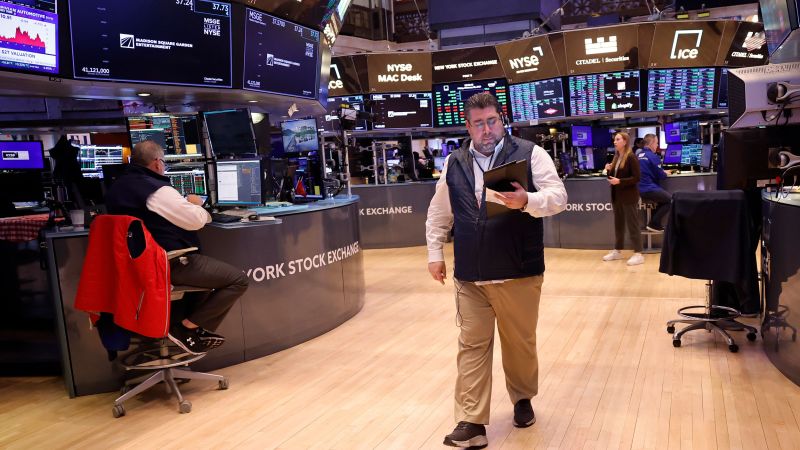A version of this story first appeared in CNN Business’ Before the Bell newsletter. Not a subscriber? You can sign up right here. You can listen to an audio version of the newsletter by clicking the same link.
Markets have been on an incredible winning streak since late October.
Just last week the S&P 500 hit a new all-time high and notched its best showing in a year. The cost of borrowing, meanwhile, has dropped to its lowest in two years, signaling a rosier economic outlook.
But this nearly unprecedented surge in the markets is sparking some concern over what’s driving the rally and whether it can continue.
What’s happening: Nvidia and other artificial intelligence stocks continued their upward trajectory on Monday after boosting markets to new highs last week.
The S&P 500 and Dow last week each reached record levels after blockbuster earnings from the chipmaker set off a broad market rally. The tech-heavy Nasdaq Composite also reached its highest level in more than a year.
The S&P 500 Health Care, Industrials, and Tech sectors also set new highs last week, said Sam Stovall, chief investment strategist at CFRA. So did 28 other sub-industries in the S&P 500.
And with less than a week left in February, all three major indexes are on pace to end the month higher.
But this isn’t just a run-of-the-mill rally. These market gains are nearly unprecedented.
The S&P 500 has now advanced for 15 of the last 17 weeks. That’s only happened one other time in the last 50 years, in 1989, according to analysts at Deutsche Bank.
If markets are positive again this week, they’ll tie the record for winning weeks last achieved in 1971.
Why the surge: The AI boom is lifting the entire market along with it.
Nvidia is already up about 60% so far this year, and the so-called Magnificent Seven stocks — Microsoft, Apple, Nvidia, Amazon, Google, Meta and Tesla – are up more than 13%. The S&P 500 is just 6.4% higher year-to-date, for comparison.
JPMorgan CEO Jamie Dimon said on Monday that the AI boom was “the real deal.”
“This is not hype. This is real. When we had the internet bubble the first time around … that was hype. This is not hype. It’s real,” Dimon told CNBC’s Leslie Picker.
Inflation is also trending lower, and Federal Reserve officials have indicated that they will likely lower interest rates this year, boosting the outlook on Wall Street.
And even though interest rates are elevated, key economic data remains strong. US unemployment is sitting at 3.7%, and S&P Global Ratings revised their forecast for US economic growth in 2024 higher just last week.
How long: The question on every investor’s mind is whether we can stay in this nearly unprecedented bull market for much longer.
This rally is vulnerable, wrote analysts at Deutsche Bank in a note Monday.
That’s largely because the rally isn’t broad enough and is concentrated in the tech sector.
The S&P 500 is up more than 6% for the year, but when you equally weigh all of the stocks in the index, it’s up just 2.5%. Last year, the S&P 500 rose by 24.2%, but the equally-weighted index was up by just 11.6%.
“That marked the first time since 1998 that the S&P 500 outpaced its equal-weighted version by more than 10 percentage points, back during the dot com bubble,” wrote Deutsche Bank analysts.
Inflation also remains a worry for traders. While long-term numbers show that price growth is easing and one month does not make a trend, January data has shown some regression.
Fed officials continued to fear that inflation could remain stubbornly elevated during their policy meeting last month, minutes released last week showed. That could keep interest rates at 23-year high for longer than previously expected, affecting Americans’ borrowing costs on everything from car loans to mortgages.
Traders now largely expect the Fed to begin cutting rates in June or July, rather than at its May policy meeting, according to the CME FedWatch Tool.
What’s next: Wall Street will closely pore over January’s PCE report. The Fed’s preferred inflation gauge is due on Thursday along with personal income and spending data.
The report follows a hotter-than-expected CPI inflation reading earlier in February that prompted markets to fall.
Berkshire Hathaway neared a $1 trillion market valuation Monday after a record-breaking year, but CEO Warren Buffett warned in his annual letter to investors that more skyrocketing performances are likely a thing of the past, reports my colleague Eva Rothenberg.
Berkshire Hathaway (BRK.B) saw its shares jump nearly 2%, to $429, on Monday morning after closing with a market cap of $905 billion on Friday. Only a handful of companies worldwide has ever reached the $1 trillion milestone, among them tech giants Amazon, Apple and Microsoft.
The Omaha, Nebraska-based conglomerate reported a record cash hoard Saturday in its fourth-quarter earnings. Berkshire has about $167.6 billion in cash and equivalents, breaking last quarter’s record-high $157.2 billion. For the year, operating earnings rose to $37.3 billion, after setting a record of $30.8 billion in 2022.
But in Buffett’s annual letter to shareholders over the weekend, the famed investor and CEO sought to manage expectations. He emphasized that longevity and constancy are at the core of the company’s ethos, adding that seismic deals and skyrocketing performance are likely a thing of the past.
“Berkshire should do a bit better than the average American corporation and, more important, should also operate with materially less risk of permanent loss of capital,” he wrote. “Anything beyond ‘slightly better,’ though, is wishful thinking.”
The Oracle of Omaha noted a lack of opportunity for Berkshire Hathaway to invest in or acquire companies that would make a strong financial impression on the conglomerate’s performance.
That is especially true for businesses outside the United States, Buffett said, noting that internationally, “there are essentially no candidates that are meaningful options for capital deployment at Berkshire.”
“Let them eat Corn Flakes” appears to be Kellogg’s CEO Gary Pilnick’s advice to cash-strapped shoppers who are spending the highest portion of their income on food than at any point in the last 30 years.
In an interview with CNBC last week, WK Kellogg CEO Pilnick said the company was advertising cereal for dinner to consumers looking for more affordable options. “Give chicken the night off,” the ad’s cheery tagline reads. WK Kellogg owns cereals such as Frosted Flakes, Froot Loops, Corn Flakes, Raisin Bran and others.
“The cereal category has always been quite affordable, and it tends to be a great destination when consumers are under pressure,” Pilnick said. “If you think about the cost of cereal for a family versus what they might otherwise do, that’s going to be much more affordable.”
His advice hasn’t landed well with people frustrated by spending 26% more on groceries since 2020; on social media the campaign is being seen as insensitive.
CNBC host Carl Quintanilla asked Pilnick if encouraging weary customers to eat cereal for dinner could “land the wrong way.”
Pilnick thought the opposite.
“In fact, it’s landing really well right now,” Pilnick said. “Cereal for dinner is something that is probably more on trend now, and we would expect to continue as that consumer is under pressure.”
Read the full article here




